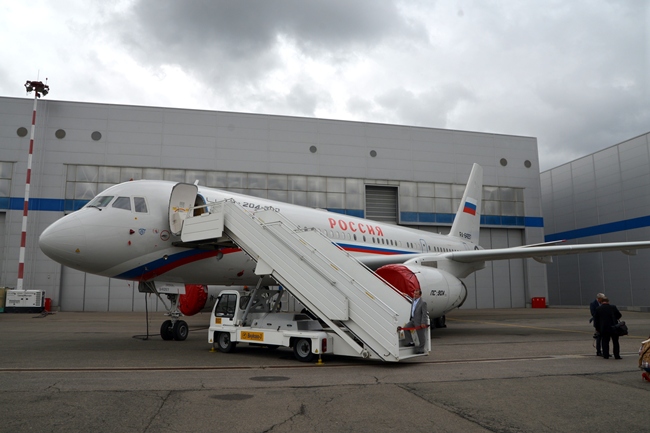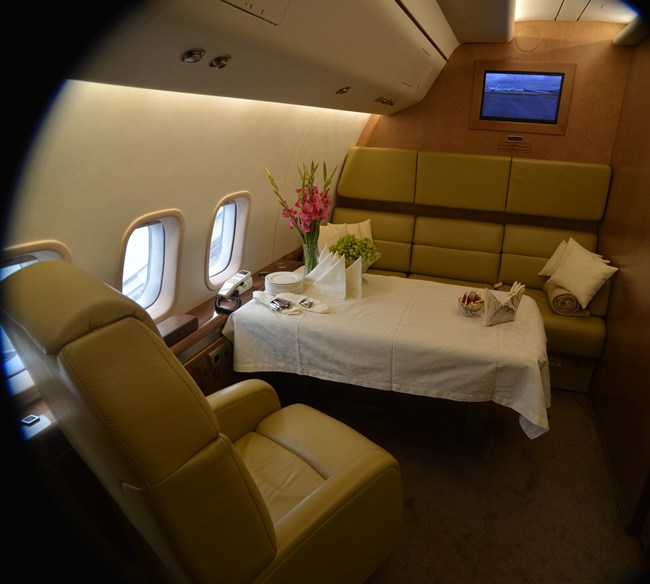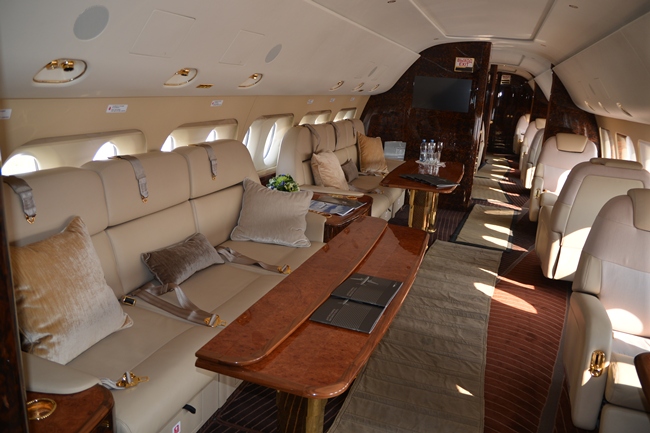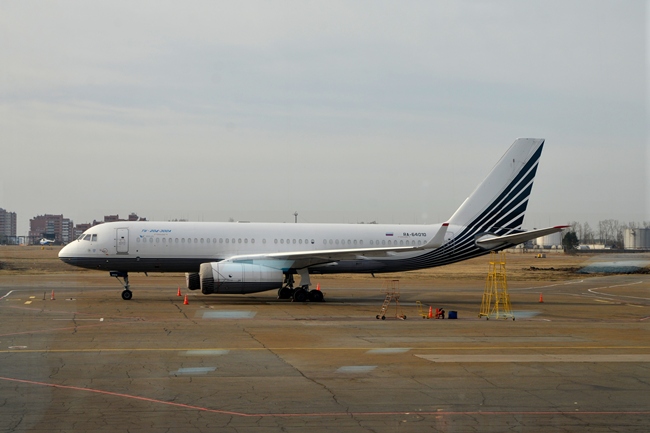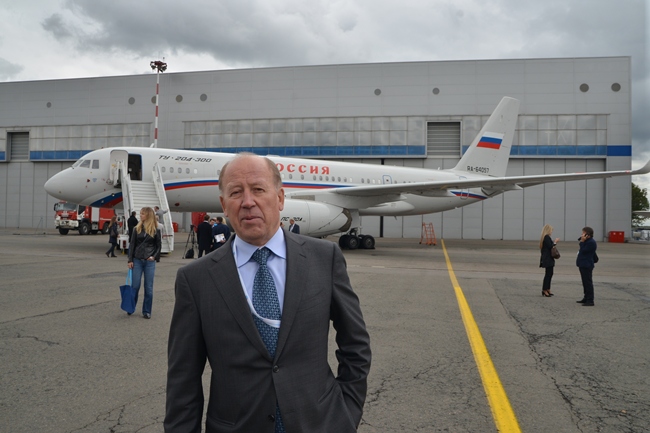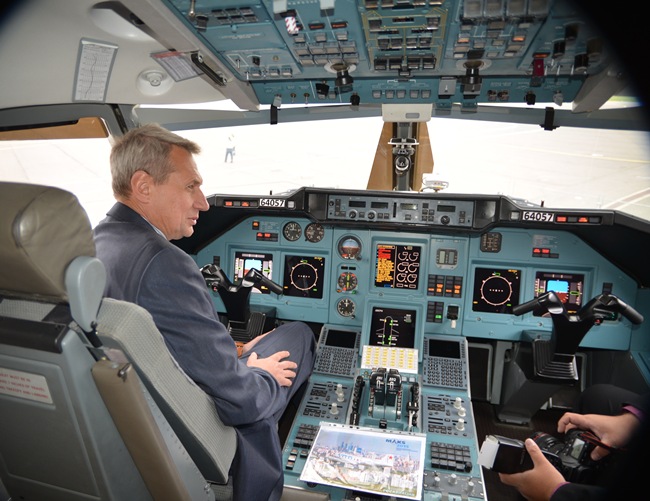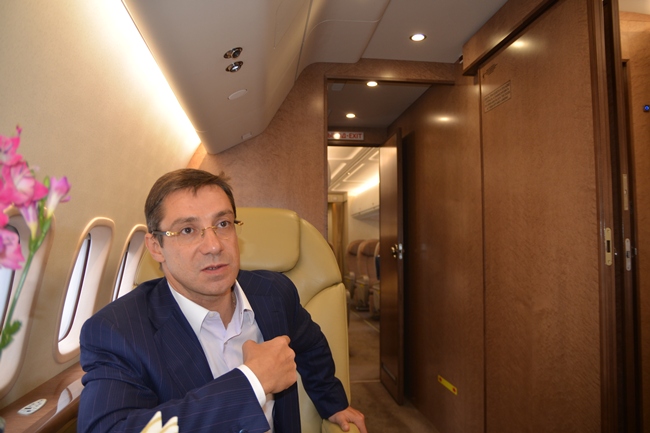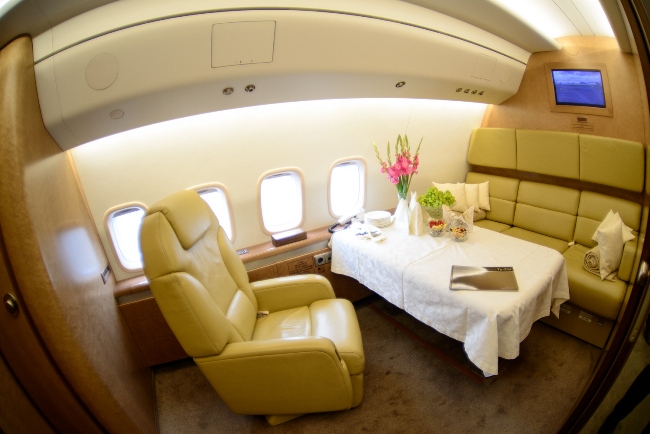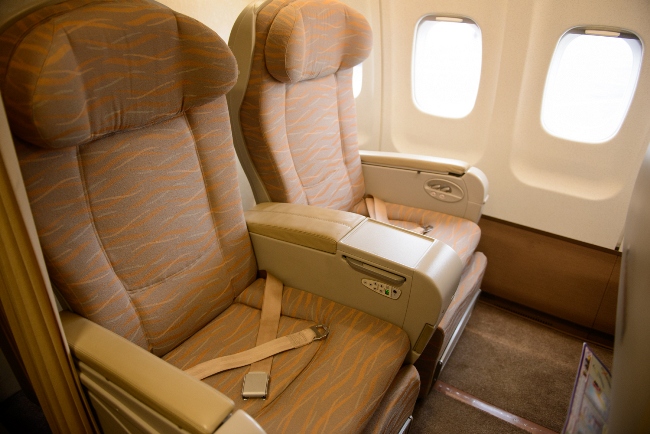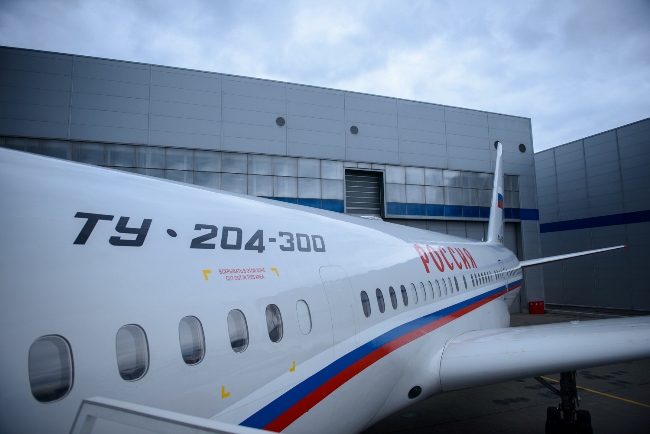First time we heard about “Plan Ten” in September 2015, at JetExpo’2015 business aviation show in Vnukovo airport of Moscow. “During the next two years a group of companies is going to rebuilt a few Tu-204 aircraft and complete them with VIP and corporate interiors”, an source in the industry told us.
The aim of this project is to see several Tu-204 airframes complete with missing parts and systems. After flight-tests, they will be sold out or leased to those who are interested in large, comfortable jets on commercial jetliner platforms. The Plan Ten has attracted a number of commercial structures, including the manufacturing plant, lessors, banks and interior specialists. Apart from the two aircraft that are already in Aviastar’s final assembly shop and soon to be handed over to the buyer, the plan calls for six more airframes to be rebuilt in 2016. This effort will continue in 2017 and, possibly, even beyond that.
First time we heard about “Plan Ten” in September 2015, at JetExpo’2015 business aviation show in Vnukovo airport of Moscow. “During the next two years a group of companies is going to rebuilt a few Tu-204 aircraft and complete them with VIP and corporate interiors”, an source in the industry told us.
The aim of this project is to see several Tu-204 airframes complete with missing parts and systems. After flight-tests, they will be sold out or leased to those who are interested in large, comfortable jets on commercial jetliner platforms. The Plan Ten has attracted a number of commercial structures, including the manufacturing plant, lessors, banks and interior specialists. Apart from the two aircraft that are already in Aviastar’s final assembly shop and soon to be handed over to the buyer, the plan calls for six more airframes to be rebuilt in 2016. This effort will continue in 2017 and, possibly, even beyond that.
With a maximum takeoff weight (MTOW) of 105 metric tons (besides, there is another version, with MTOW of 107.5 tons), the Tu-204-300 VIP can transport 25 passengers 9,500 km. To fly that far, the aircraft is equipped with additional fuel tanks. This boosted total fuel capacity to 41.87 tons. The aircraft comes equipped with PS-90A turbofans (developer: Aviadvigatel design house, maker: Perm Motor Plant) and TA-12-60 APU that were subjected to major overhaul as part of the aircraft refurbishment effort. After refit, the airframe is given lifetime of 45 thousand flight hours or 25 takeoff/landing cycles.
Largest and most interesting exhibit
In the fall of 2015, the finance-industrial group behind the Plan Ten was obliged by the Special Air Detachment “Rossiya” [“Russia”, local abbreviation SLO] serving members of the Presidential Administration and cabinet of ministers of the Russian Federation. This operator made decision to take part in JetExpo’2015 and exhibit one of its Tu-204-300 VIP aircraft.
JetExpo’2015 static line was dominated by the Tu-204-300 VIP registration RA-64057. Largest exhibit on display, this big machine dwarfed Bombardier, Gulfstream, Dassault and Cessna business jets parked nearby. Of all the numerous foreign assets at the show, the ACJ319 operated by MJET came nearer in size and interior outfit.
The RA-64057 was available for inspection during the opening day only. It was gone next morning, to empty the place for a Sukhoi Superjet 100. The replacement aircraft bore registration RA-89053. It also represented the local school of turning a passenger jetliner into VIP jet. Unlike the RA-64057, however, this machine had been exhibited before. The aircraft was on display at MAKS’2013. That time it bore registration RA-97009 and featured a mockup interior for customer demonstration. At JetExpo’2014 the very same aircraft appeared in the guise of “Sukhoi Business Jet” (SBJ). It became an exhibit again at MAKS’2015 as “Superjet 100-95B VIP”, showing another registration and reworked interior.
The RA-64057 and its sister ship, the RA-64058, are the two aircraft in a batch ordered by the Presidential Administration. Both were assembled in 2011 and became operational in 2012. The RA-64057 has a luxurious cabin for a maximum of 65 passengers. The forward section is portioned off so as to create maximum comfort for the main passenger. There is a bedroom suite complete with a bathroom with a shower at his disposal. The middle of the aircraft houses a conference room and a dozen of business class seats, while the rear represents a typical airline economy class section with 26 rows of six-abreast seating.
Happy with the performance of these two aircraft and their comfort features, the customer placed a follow-on order for two more. These governmental orders were very important for the plant since, by the time they were placed, those from the airlines and leasing companies had already been fulfilled. In particular, Aviastar completed the last Tu-204-100V for Ilyushin Finance Co. in 2010. That aircraft went to Red Wings airline, the largest commercial type operator.
Historically, the very first Tu-204 with shortened fuselage and high-comfort interior was made for VTB, one of the top Russian banks. Bearing registration RA-64010, the aircraft has been flying with Business Aero since the middle of 2009. This modification is referred to as the Tu-204-300A. Reportedly, the aircraft has additional fuel tanks for an increase in fuel capacity from 36 to 42 tons. Range with customer-specified payload is 9,600 km.
Cabin interior for the RA-64010 is from the Tupolev design house. It features a shower room, a satellite communications systems and mood lighting (colors and intensity are controlled by cabin crew and the main passenger). This aircraft has interior for a maximum of 26 travelers, but normally the aircraft rarely takes more than 18. Reportedly, it has flown a number of transcontinental flights, including those from Moscow to destinations in the United States.
«This is exactly what we must develop further»
Journalists of our publication were among the lucky few who could make it into the governmental aircraft while it was on display at JetExpo’2015. We were accompanied by the general manager of Vnukovo airport. Vasily Aleksandrov spoke us on a number of issues, including the business aviation activities in his airport.
“Vnukovo is famous for being the undisputed leader in this sort of aviation activities among other airports serving the capital city. Our share in total business aircraft traffic through the Moscow Air Knot is above 70%. The Vnukovo-3 business aviation center is the jewel in our crown. Here you can see the fastest and the most luxurious business jets of them all. They fly even in crisis despite rather tough economic realities of these days. This means that the sector of business aviation is alive and well”.
Consumers of business aviation services are rather choosy, he noted. At the same time, the science, manufacturing, design and fashion industry have developed so much that the manufacturers can meet demands of most customers willing to pay for their dreams to materialize. And business jet users are quite numerous, with the world’s fleet accounting for some eighteen thousand aircraft.
“Should a client want a shower and a wide cabin with a high ceiling, he may find the SLO aircraft a good proposition. The aircraft here on display features a modern design of the passenger cabin from specialized local companies. Today, when the Russian government calls “buy Russian” and carries out ”Import Substitute” policy, this is exactly what we must develop further”, Aleksandrov said.
Pilots in Russia and some client states have mastered the Tu-204. Earlier this century a dozen of new-generation Tupolev jetliners were operated successfully on long range services connecting Moscow and St. Petersburg to destinations on Russia’s Pacific Coast. Dalavia (Far East Airlines) operated the Tu-214, and Vladivostok Avia the Tu-204-300.
Mister Aleksandrov recalls: “When I travelled to the Far East, I had a chance to speak to flight crews of these airlines. They told me that, on these long haul routes, this type is more effective than Airbuses. It demonstrated a higher level of readiness and maintainability. Monthly utilization per an operational airframe peaked at 400 hours, which was quite an achievement. So, this was their argument in support of quantity production of this type. Should the production rates be higher, some technical issues could be resolved through the scale of manufacture. Every new type has teething issues and some problematic points. By streamlining production, you can get these issues solved, so that the operational aircraft would demonstrate even better performance than they had while in service with these airlines”.
Today, such comments must be viewed through the age of the aircraft design: development of the Tu-204 started in the 1980s. “This aircraft did not happen to explore fully the potential which has been downloaded into it by the engineers. This was due to a number of causes, and I do not want to speak of them today. As proverb goes, “there are no prophets in the land…” When the Tu-204 was first demonstrated to the West at one of the airshows out there, local media wrote the Tu-204 had the best wing design of all known jetliners in this class”.
In conclusion, Aleksandrov told us the following words. “When you attend a good aviation museum with a wide collection of aircraft,you can see lots of aircraft that were built in one or few copies, and but did not make it into mass production. They did not succeed, but they provided base for development of more advanced aircraft. So, they served as a firm ground for success of other aircraft that followed. In that connection, I believe that the Tu-204 provides a good foundation to development of next generation jetliners. The MC-21, which is the next Russian design in that class, shall be a next step forward”.
«The Tu-204 is ideal for corporate use»
A number of Russian companies took part in completion of the RA-64057. Among them there are members in AKAI, local acronym for Association of Aviation Interior Companies.
AKAI president Vitaly Romanyuk told us the following. “This aircraft provides a good example of what Russian completions specialists can offer the business aviation community. In my option, the Tu-204 is ideal for corporate use, as well as for special missions or governmental needs. With additional fuel tanks installed, the Tu-204-300 can cover a distance of up to ten thousand kilometers without a fuel stop. When you fly that far, the flight duration comes to 12-13 hours”.
For people aboard to feel good during the entire journey, AKAI has developed a number of solutions aimed at improving the level of comfort. “Today, we offer a number of interior design options for the Tu-204/214 family so that the customers do have a choice. As a rule, the forward section is configured for the main passenger. There is a sleeping chamber or a big folding/unfolding sofa in a full-size workroom. Besides, there is a shower room and a washroom at his disposal. The pilots can have a nap in the crew rest area. Overall, aircraft of that size have enough space to render a sufficient comfort level for people on board. This is very important in the case of long-haul flights”.
“Depending on what the customer wants its aircraft to be used for, we offer cabin layout with a conference room with a large table and many seating places. This is a must in case the customer wants to hold business meetings, conference or discussions on board the aircraft. The cabin may come with a business class section or a section with sleeping chairs. We also offer folding/unfolding sofas which can turn a work room into a sleeping compartment. If the main passenger often takes many people with him on a journey, the cabin should have an economy class section at the back”.
The RA-64057 began operations with SLO in January 2012. How has the aircraft performed since then? Vitaly Romanyuk answers: “This aircraft has been in service for some four years now. And, as you can see, it is still in a very good shape. This is another proof that Russian technologies and workmanship are good, and that the Russian products are durable. Investments in them do pay off and bear fruits”.
As mentioned before, two more Tu-204-300 VIP aircraft are in the final assembly shop at Aviastar, soon to be completed. Broadly speaking, they are similar to the RA-64057. According to plan, the delivery shall take place in 2016. “Are you sure AKAI members perform well and in line with the delivery terms?”, we asked mr. Romanyuk. “Yes, I am positive”, he answered.
“We completed all interior items a long ago. All what could have been done in our workshops was done. What’s left is installation work at Aviastar. Most of that work is the responsibility of the manufacturing plant. Our specialists and employees of other vendors are there, working hand-in-hand. I believe the delivery terms will be met, and that the customer will accept both airplanes in 2016”.
Among AKAI members involved in this project there are Vemina-Aviaprestige, Kvand, Aerostyle, AKKO etc. “We have been doing everything to reduce import intake to an absolute minimum. With this in mind, we have moved into Russia all sort of work that could be done in this country, as far as interior issues are concerned. We have built new workshops and equipped them with relevant tools. We have trained personnel in the use of those tools. As a result of our consistent efforts, foreign supply is confined to raw materials and other essentials that are not produced in this country”.
Upholstery and other items for “finishing” take the biggest part of the current import. “It is ought to remember that all materials and components for aviation interiors must have valid certificates issued or approved by aviation authorities. Among the items we are importing there coating, linings and tapes, rare kinds of wood/timber and natural leather, chemicals, glues, and parts in mechanisms. As per mechanisms, we do most of them ourselves, using some parts and raw materials bough elsewhere”.
The number of Tupolev, Antonov and Ilyushin aircraft accepted into service this century by various governmental structures is measured with too digitals. Most of them have high comfort interiors from AKAI members. This finds reflection in the fact that the companies of the Association have amassed good experience. We asked Romanyuk to highlight some tendencies.
“The technologies are developing further, and today we are offering a number of improvements. There are many things worth mentioning, and I’ll give you few examples. Mechanisms to lift tables have been much improved, as well as those to fold tables into sidewalls. Seat designs have been improved. Requirements to them – as set by the aviation authorities - have tended to become stricter. Even though the requirement for first and business class to withstand 16g load appeared some time ago, it proved quite a challenge for us. It took us time to manage this issue. Today, our products are compliant with this and other requirements. Each aircraft we worked on saw quality of our work getting better. As a result of the persistent improvement, the quality has markedly and visibly risen.
Romanyuk also praised the Vemina fashion house, which is a sister company to Vemina-Aviaprestige. “We have developed a big variety of styles. So, there is a vast variety of design features, but the governmental customers tend not to request them, preferring instead a classic style for their aircraft cabins. Luckily, this does not entail “preservation” of outdated design solutions in aircraft interiors. Besides, some solutions find clients in the business community. So during the past few years we witnessed a big limp in the cabin design”.
According to AKAI members, the Tu-204 project they are involved in has won support of some leasing and financial structures. Leasing Avia company, based in Ulianovsk, with help of financial institutions from St. Petersburg, is to provide funds for components such as Aviadvigatel/Perm Motors PS-90A turbofans, Stupino TA12-60 APUs and avionics blocks from KRET.
Global and domestic markets
Airbus Corporate Jets (ACJ) held a press briefing timed to JetExpo’2015. The company announced that, for the calendar years 2010 to 2014, Airbus has beaten Boeing in both orders and deliveries, excluding military customers. The figures we received from the European manufacturer included: Orders: Airbus 30 compared with Boeing’s 25. Deliveries: Airbus 45 compared with Boeing’s 44.
Director for marketing David Velupillai acknowledged that “Boeing has had slightly higher total for orders and deliveries than us, because it has been in the market longer. Boeing is a strong competitor, but it is a big world and the market is large enough.” Since 1998, the U.S. manufacturer has sold about two hundred jetliner conversions into business and corporate versions under brand of “Boeing Business Jets”. Its European competitor has made over 170 sales.
The Russian business jet fleet is estimated at 542 units (JETNET/AvData 2015). Most of aircraft in it are from foreign manufacturers, and include some thirty ACJs and twenty five BBJs (these numbers cover Russia and other CIS countries).
In many ways ACJs and BBJs that use the platform of A320 and B737 jetliners are similar in performance to the Tu-204-300 VIP. With a floor space of some one hundred square meters, the Tu-204-300A offers same or even more speciousness. The version with a 107.5-ton MTOW has longer range than the ACJ320. Airbus shall attain parity only after introduction of the ACJ320neo, with advertised performance of 11,000 km range with 25 travelers aboard. But it is going to be available until a few years from now.
At the same time, there is no much competition coming from the side of dedicated business jets. This is because the latter are markedly smaller in cabin size. The Gulfstream G-650, for instance, is, indeed, a very modern and advanced aircraft. But those who are looking for top comfort and ready to pay for it, prefer jetliner conversions, because they offer more cabin space. At a catalogue price of U.S. dollar 66 million, the G-650 sells for some twenty million less than the smallest ACJ. From a viewpoint of marketing, that’s a huge difference. And it is so for the customers.
“Those who buy ACJ, make their choice in favor of cabin speciousness and comfort”, David Velupillai says. This will continue to be the case for foreseeable future, he believes.
In the light of the Kremlin’s “Buy Russian” and “Import Substitute” policies, it can be envisioned that the business jets imported into Russia will be gradually replaced by local substitutes. The Tu-204-300 VIP and Sukhoi Business Jet (the latter is offered at U.S. dollar 50 million) are good enough in terms of flight performance and cabin spaciousness to compete with ACJs, BBJs and Embraer Lineage 1000. That is what we were told not only by the industrials and lessors, but also by those who operate these aircraft and fly them as passengers.





